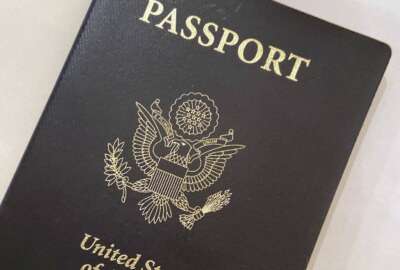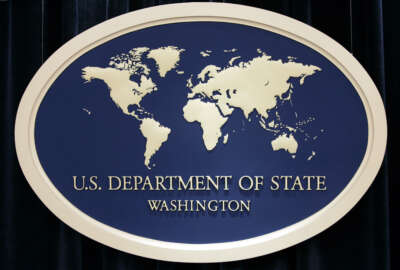This State Department IT project started in 2009 and it’s nowhere near finished
From its embassy buildings to how it conducts diplomacy, the State Department has been on a modernization drive.
Best listening experience is on Chrome, Firefox or Safari. Subscribe to Federal Drive’s daily audio interviews on Apple Podcasts or PodcastOne.
From its embassy buildings to how it conducts diplomacy, the State Department has been on a modernization drive. That also includes its information technology. The Bureau of Consular Affairs has been working to consolidate 90 systems into one system. That effort is known as ConsularOne. It’s not going all that great and for the latest from the State Department’s Office of Inspector General, Vandana Patel, a senior Information Management inspector, and Lisa Piacik, a consular inspector, spoke to the Federal Drive with Tom Temin.
Interview transcript:
Tom Temin: Alright, let’s begin here with the fact that this project in some form was conceived back in 2009. And we know sometimes federal IT projects take a long time. But what’s going on that here we are 11, 12 years later and they’re still working on it?
Vandana Patel: Yeah, so we actually have reported on ConsularOne modernization program over the last couple years in fact, Tom. For example, in our March 2016 audit report, at that time, our audit team had reported that ConsularOne had failed to meet performance goals since 2012. And later on in the year, we also did an OIG inspection of the Office of Consular Systems and Technology, which is the business owner for the ConsularOne one monetization program. And at that time, we also found that there was issues regarding no ConsularOne components had yet been deployed. Our inspection, the one that we are speaking about today, we found that since the 10 years of the ConsolularOne modernization effort has been underway, there’s only been a very limited pilot that was done of one component. And that was also done to six overseas posts. However, we found that there seems to be a issue with continued delays and missed deployment dates for a lot of the other components under the program. And we found that there’s multiple factors that have caused these delays in regards to the ConsularOne modernization program. And they can be grouped in five different areas. We found issues and deficiencies in leadership, management of resources, communication, project management, as well as information security management.
Tom Temin: Yeah, that covers pretty much the gamut of things. And just to help set the scene a little bit the Bureau of Consular Affairs deals with overseas operations or where do they live, you know, within the State Department?
Vandana Patel: Sure. So the Bureau of Consular Affairs is responsible for doing passport issuance. It also at our overseas embassies and consulates handles services for Americans. They also assist with visas for foreign assistance. Now, within the Bureau of Consular Affairs, the Office of Consular Systems and Technology, known as CST, I mentioned serves as the business owner for ConsularOne.
Tom Temin: Alright. And also if you would maybe review some of the functions that they’re trying to get under one unified system that are related to those particular missions?
Vandana Patel: Yeah, so they’re working on, they have five different pillars that have different components to try to focus on the legacy systems and to modernize those services [that] are provided. For example, one of the components that we mentioned earlier is the eCRBA, it’s to handle the electronic childbirth records abroad. The other components are looking at the visa operations. They also are working on modernizing their systems to handle online passport renewals.
Tom Temin: Right. And that’s supposed to roll out in the coming year. Correct?
Vandana Patel: Correct. But what our team found that there has been some delays in regards to moving forward with the deployment of that particular component.
Tom Temin: Alright, maybe we’ll come back to that in a moment. But let me ask you this: Often, these long term modernization efforts have a prime contractor. In the case of say the IRS over 25 or 30 years they’ve had a series of prime contractors. What’s the situation with respect to the contracting portion of this whole program?
Vandana Patel: So contract management was actually not part of our inspection scope. However, with that being said the staff resources within a Consular Systems and Technology Office is a heavily contractor staff. So we do feel that contract management oversight is likely a contributing factor to the delays with ConsularOne modernization effort. However, we do have future OIG work that’s in particular going to be looking at the contract and seeing if they are in compliance with federal regulations and department policy.
Tom Temin: We’re speaking with Vandan Patel, senior Information Management inspector and Lisa Piacik, a consular inspector, both with the State Department’s Office of Inspector General. And getting back to those five deficiencies, I mean, security program management, communications management of the program, and the top one is leadership, which I guess affects all of the others, what is the leadership issue? Is it turnover or lack of attention or what?
Vandana Patel: It actually had to do with the definition of how they are defining the ConsularOne program, but more importantly, as our report indicated it had to do with staff and management accountability. And I will let Lisa speak to that.
Lisa Piacik: Yeah, we found in looking at C operations, that leadership was just not holding its managers and its supervisors accountable for either the deployments, the missed deployment dates for the ConsularOne project, or for the failure of these products to meet quality standards. The reasons for this vary, but you see it really needs to do a better job in making sure that these things are kept on track.
Tom Temin: And so to date then they have deployed a single component at only six places out of a potential, I guess, 80, 90, 100 overseas. What is the one piece they’ve got partially done?
Vandana Patel: It’s called the eCRBA, it’s the electronic childbirth abroad records, that’s the one component that has been piloted to six posts at this moment.
Tom Temin: Okay, so a pilot at six posts then is really not deployed in the sense that it’s a operational system. Does it have an ATO to go State Departmentwide? Or is it just right in testing at this point?
Vandana Patel: They are pushing forward to do a deployment 2.0, which it was scheduled. During our inspection, we found that it was supposed to be released later on this year. However, as our report indicated, there are some delays regarding the various components with the ConsolularOne modernization effort.
Tom Temin: And the passport online system, that’s really a strategic piece for the State Department. And now it’s got the attention of the administration has put it in its Better Service to the Citizen plan, as part of the President’s Management agenda. So where does that stand now and what could hold it up for deployment in 2022?
Vandana Patel: As our report indicated, OPR was planned release date of December 2021. However, it has missed previous release dates. So we are under the impression right now, as our report indicates that it is delayed.
Tom Temin: Right. And they’re saying it’s going to be sometime in 2022 after some online testing, are you confident that that will happen?
Vandana Patel: That’s a question that we can’t answer. Our report was just strictly looking at the ConsularOne modernization effort and the delays and the causes behind its delays. So we cannot comment on that.
Tom Temin: Okay, well, maybe I’ll make an opinion when I write a column about this. But let me ask you this, given all of these situations, five major contributors to delays and maybe perhaps contractor problems, what were your major recommendations here to the ConsularOne project people?
Vandana Patel: Yeah, so our report actually had 11 recommendations to identify the causes that were reported in the report. For example, some of our key recommendations address leadership issues, by asking the bureau to clearly define the ConsularOne modernization program to include its components, projects, supporting contracts, as well as the associated total costs. We also recommended that the bureau hold managers and staff accountable for performance and deliverables for the ConsularOne in accordance with our department standards. Additionally, we also had a recommendation that looked at the bureau’s leadership, and asking them to review the deployment schedule for the ConsularOne components to see if the schedule was actually achievable, and will meet the bureau’s goals and mission.
Tom Temin: And does the bureau generally say yeah, you’re right about all this?
Vandana Patel: Yes so they agreed with our recommendations. Of the 11, eight of them, they are considered resolved, meaning that they are working towards addressing those recommendations or the intent of those recommendations. Three of them are considered unresolved where during our compliance process, which has started with the issuance our report, they will be pointing back to us on what steps you’re going to be taking to address all of these.
Tom Temin: And just a question, maybe you can address this, maybe not. But a lot of agencies that have these overarching large visionary programs in place have turned to the scrum, the 90-day sprint, the agile development methodology such that they can deploy small modules. And over time it adds up to total automation or modernization. Is that something they’re trying to do there or something you recommend that they do?
Vandana Patel: Yeah, so they have a systems development methodology underway. They’re doing traditional methodology as well as agile. So what we found is that while they have this methodology in place, as our report indicated, there are some areas regarding project management that could be improved. For example, we noted that there was lack of documented management approvals, and there was also some attention that needed to be placed on developing a central retention for project documentation for ConsularOne.
Tom Temin: And what have they spent so far and all of this since 2009? Or maybe it was pre-baselined, or redesigned in 2011?
Vandana Patel: Yeah, so what we found is that, since like we mentioned in our report, there were some various information that was provided to us regarding the contracts and also there seems to be a lack of clarity regarding the definition for the ConsularOne modernization program. So our team was unable to really determine the total cost for the effort with position with precise amount. What we are saying in our report, between $200-$600 million have been spent on this effort.
Tom Temin: Yeah, so a pretty wide range of possibility and for all we know it could be twice that much.
Vandana Patel: That would be something we think our future OIG work will be getting into and hopefully getting that answer.
Tom Temin: Alright. Vandana Patel is a senior Information Management inspector and Lisa Piacik is a consular inspector, both with the State Department’s Office of Inspector General. Thank you both for joining me.
Vandana Patel: Thank you for having us.
Lisa Piacik: Thank you.
Copyright © 2024 Federal News Network. All rights reserved. This website is not intended for users located within the European Economic Area.
Tom Temin is host of the Federal Drive and has been providing insight on federal technology and management issues for more than 30 years.
Follow @tteminWFED






